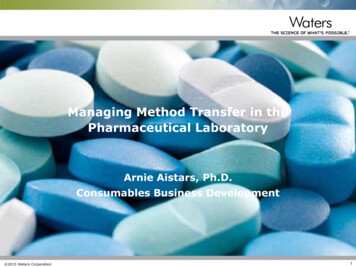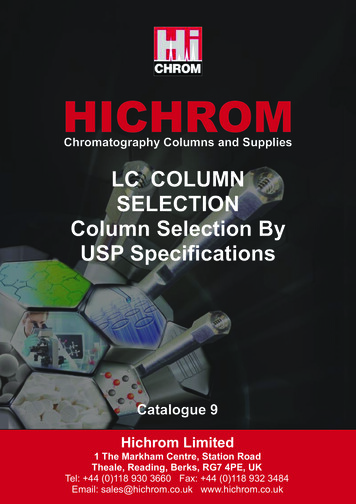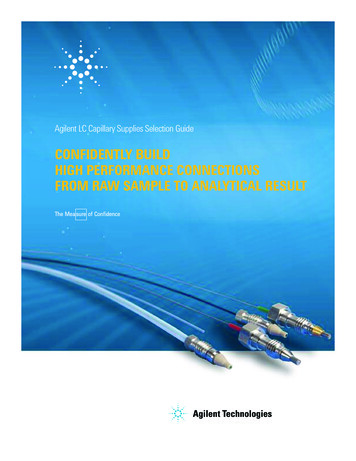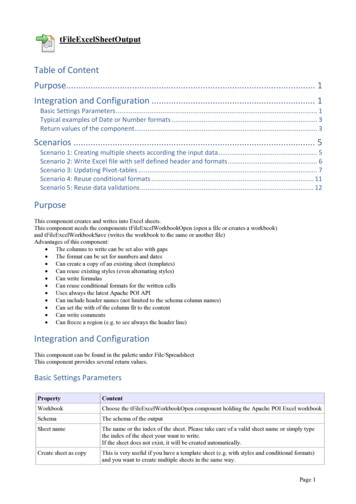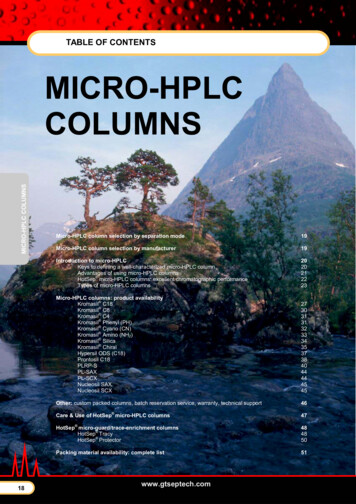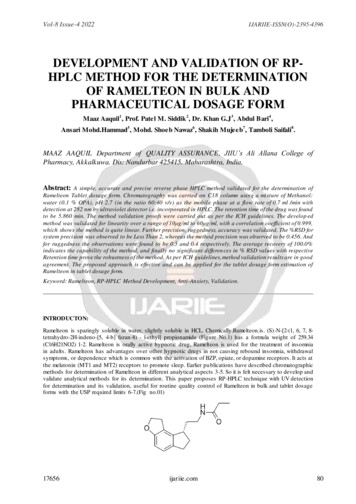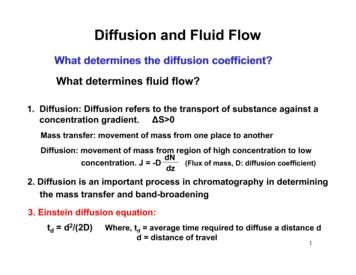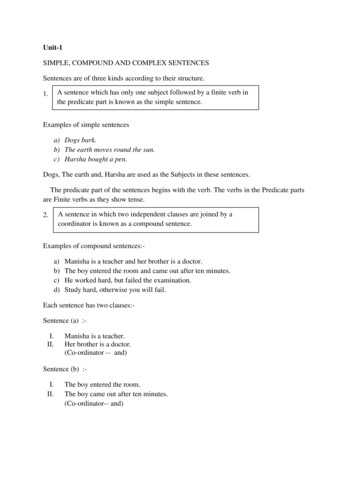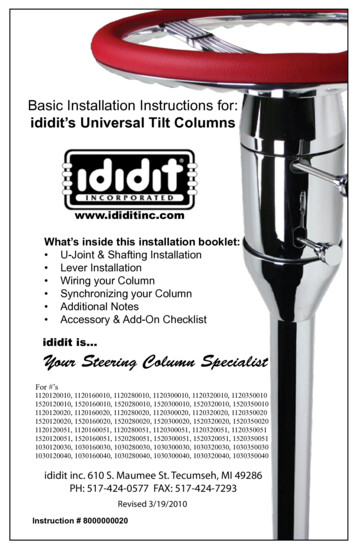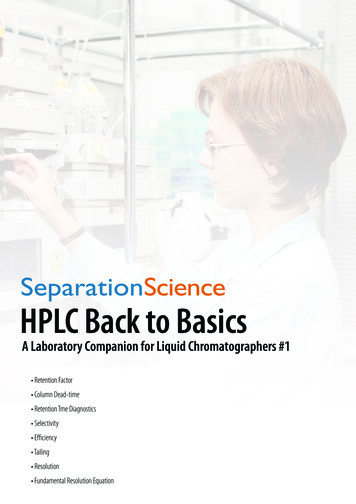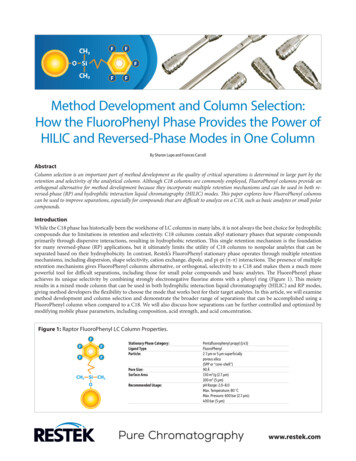
Transcription
Method Development and Column Selection:How the FluoroPhenyl Phase Provides the Power ofHILIC and Reversed-Phase Modes in One ColumnBy Sharon Lupo and Frances CarrollAbstractColumn selection is an important part of method development as the quality of critical separations is determined in large part by theretention and selectivity of the analytical column. Although C18 columns are commonly employed, FluoroPhenyl columns provide anorthogonal alternative for method development because they incorporate multiple retention mechanisms and can be used in both reversed-phase (RP) and hydrophilic interaction liquid chromatography (HILIC) modes. This paper explores how FluoroPhenyl columnscan be used to improve separations, especially for compounds that are difficult to analyze on a C18, such as basic analytes or small polarcompounds.IntroductionWhile the C18 phase has historically been the workhorse of LC columns in many labs, it is not always the best choice for hydrophiliccompounds due to limitations in retention and selectivity. C18 columns contain alkyl stationary phases that separate compoundsprimarily through dispersive interactions, resulting in hydrophobic retention. This single retention mechanism is the foundationfor many reversed-phase (RP) applications, but it ultimately limits the utility of C18 columns to nonpolar analytes that can beseparated based on their hydrophobicity. In contrast, Restek’s FluoroPhenyl stationary phase operates through multiple retentionmechanisms, including dispersion, shape selectivity, cation exchange, dipole, and pi-pi (π-π) interactions. The presence of multipleretention mechanisms gives FluoroPhenyl columns alternative, or orthogonal, selectivity to a C18 and makes them a much morepowerful tool for difficult separations, including those for small polar compounds and basic analytes. The FluoroPhenyl phaseachieves its unique selectivity by combining strongly electronegative fluorine atoms with a phenyl ring (Figure 1). This moietyresults in a mixed-mode column that can be used in both hydrophilic interaction liquid chromatography (HILIC) and RP modes,giving method developers the flexibility to choose the mode that works best for their target analytes. In this article, we will examinemethod development and column selection and demonstrate the broader range of separations that can be accomplished using aFluoroPhenyl column when compared to a C18. We will also discuss how separations can be further controlled and optimized bymodifying mobile phase parameters, including composition, acid strength, and acid concentration.Figure 1: Raptor FluoroPhenyl LC Column Properties.FFFFFCH3 Si CH3OStationary Phase Category:Ligand TypeParticle:Pore Size:Surface AreaRecommended Usage:Pentafluorophenyl propyl (L43)FluoroPhenyl2.7 µm or 5 µm superficiallyporous silica(SPP or “core-shell”)90 Å150 m2/g (2.7 µm)100 m2 (5 µm)pH Range: 2.0–8.0Max. Temperature; 80 CMax. Pressure: 600 bar (2.7 µm);400 bar (5 µm)
Multiple Retention Mechanisms Give FluoroPhenyl Columns Alternate Selectivity to a C18Efficient, effective method development depends on column selection. Early identification of the best column for the target analyte(s)can save time when developing a new method. The alternate selectivity provided by FluoroPhenyl columns, when compared to aC18, can aid method developers by allowing them to utilize multiple retention mechanisms in a single column. We chose severalchallenging target analytes (Figure 2) to illustrate the unique retention characteristics of the FluoroPhenyl phase and to examineits performance in both HILIC and RP modes. All of these analytes were selected because they exhibit poor retention, poor resolution—or both characteristics—on a traditional C18 stationary phase.Figure 2: Test Probes Used to Demonstrate the Multiple Retention Modes of Raptor FluoroPhenyl zole (4-MEI)Epimers of Vitamin D3H2CH2COHOHShape-Selective Retention of Vitamin D Isobars in Reversed-Phase ModeIn our first example, we evaluated the analysis of 25-hydroxyvitamin D3 and its C3 epimeric form, a separation of increasing relevance in clinical labs around the world. 25-Hydroxyvitamin D3 is an important biomarker used in the determination of faultyvitamin D metabolism. The C3 epimeric form (3-epi-25-hydroxyvitamin D3) has much lower bioactivity and can cause biomarkervalues to be overestimated if not reported individually. Because these compounds are isobaric, chromatographic separation is essential for the accurate determination of biological levels. As shown in Figure 3, the use of a FluoroPhenyl column in standard RP modeallows complete separation of 25-hydroxyvitamin D3 and its C3 epimer in just five minutes. In contrast, on a C18 column the elutiontime was three times longer and adequate separation was never achieved. In this example, column selection clearly plays a key rolein method development: the rigid structure of the FluoroPhenyl phase provides additional shape selectivity and substantially moreresolving power than can be achieved using the hydrophobic retention of a C18 column.www.restek.com2
Figure 3: Vitamin D analysis is more accurate on a FluoroPhenyl column because its shape-selective retentionseparates the C3 epimer from the bioactive form.1Raptor FluoroPhenyl2Conc.PeaksMRMtR (ng/mL)1. 25-Hydroxyvitamin D3401.5/383.4 3.59502. 3-Epi-25-hydroxyvitamin D3 401.5/383.4 Particle Size:Temp.:SampleDiluent:Conc.:Inj. Vol.:Mobile PhaseA:B:5.00.51.01.522.02.53.0Time (min)3.54.0Raptor ARC-182.04.53.04.05.0PeaksMRMtR1. 25-Hydroxyvitamin D2413.5/355.5 10.382. 3-Epi-25-hydroxyvitamin D2 413.5/355.5 10.382.0DetectorIon Mode:Mode:InstrumentMS/MSESI MRMHPLCColumnDimensions:Particle Size:Temp:SampleDiluent:Conc.:Inj. Vol.:Raptor ARC-18 (cat.# 9314A12)100 mm x 2.1 mm ID2.7 µm30 C%B758510010075755.0LC CF0644Conc.(ng/mL)50256.07.08.09.010.011.012.01, 21.00.1% Formic acid in waterMethanol1, 2PeaksMRMtR1. 25-Hydroxyvitamin D3401.5/383.4 9.362. 3-Epi-25-hydroxyvitamin D3 401.5/383.4 9.361.0Water:methanol (50:50)25-50 ng/mL5 µLTime (min) Flow (mL/min) .6251Conc.PeaksMRMtR (ng/mL)1. 25-Hydroxyvitamin D2413.5/355.5 3.73502. 3-Epi-25-hydroxyvitamin D2 413.5/355.5 3.9125Raptor FluoroPhenyl (cat.# 9319A1E)100 mm x 3 mm ID2.7 µm30 C3.04.05.013.0Mobile PhaseA:B:0.1% Formic acid in waterMethanolTime (min) Flow (mL/min) Conc.(ng/mL)50256.0Water:methanol (50:50)25-50 ng/mL5 µLDetectorIon Mode:Mode:Instrument7.08.09.010.0Time (min)11.012.0MS/MSESI MRMHPLC13.0LC CF06493www.restek.com%B7580807575
Cation-Exchange Retention of Small Polar Compounds in HILIC ModeOur next example demonstrates the cation-exchange mechanism of the FluoroPhenyl phase and its effectiveness in retaining smallpolar compounds. 4-Methylimidazole (4-MEI) is an additive that is used as a caramel coloring in food and beverages. Like othersmall polar compounds, it is difficult to analyze using standard RP chromatography and a C18 column because it has limited retention on a nonpolar stationary phase. However, in an acidic solution, 4-MEI has a positive charge, which makes it very amenableto cation exchange and easy to retain on a FluoroPhenyl column under HILIC conditions. This occurs because the electron withdrawing nature of the five fluorine atoms imparts a slight negative charge to the stationary phase. As shown in Figure 4, when ahigh proportion of acetonitrile is used in the mobile phase, cation-exchange interactions dominate retention and 4-MEI is retainedwell. Under reversed-phase conditions, retention of the FluoroPhenyl column is dominated by dispersive interactions and 4-MEI ispoorly retained. The FluoroPhenyl phase gives analysts the flexibility to evaluate performance in both RP and HILIC modes in orderto base method development decisions on which mode is most effective for their compounds of interest.Figure 4: Small polar compounds, such as 4-MEI, are difficult to retain under RP conditions, but adequate retentionis easily obtained under HILIC conditions on a FluoroPhenyl column.Peaks1. 4-Methylimidazole (4-MEI)0% B10% B20% B30% B40% B50% B60% B70% B80% B90% B0.00.20.40.60.81.01.21.41.6Time (min)1.82.02.22.4LC FF0562ColumnDimensions:Particle Size:Temp.:SampleDiluent:Conc.:Inj. Vol.:Mobile PhaseFlow:DetectorIon Mode:Mode:Instrumentwww.restek.comRaptor FluoroPhenyl (cat.# 9319A52)50 mm x 2.1 mm ID2.7 µm35 CAcetonitrile100 ng/mL5 µL0.1% Formic acid in water:0.1% formic acid in acetonitrile0.6 mL/minMS/MSESI MRMUPLC42.62.83.0
Fine-Tune Retention and Selectivity with Modified Mobile Phase ParametersAs previously established, effective method development depends on careful column selection, and the multiple retention modesof the FluoroPhenyl phase provide more flexibility than is possible with single retention mode C18 columns. In this section, wewill explore ways to optimize separations by modifying mobile phase composition, acid strength, and acid concentration. For theseexperiments, several common drug compounds were selected to demonstrate the varied retention behaviors of the FluoroPhenylstationary phase (Figure 5). These chemical probes represent bases, weak acids, and neutral compounds and highlight differences inthe selectivity and the affinity of the FluoroPhenyl phase for hydrophilic and basic compounds.Figure 5: Test Probes Used to Demonstrate the Multiple Retention Modes of Raptor FluoroPhenyl ColumnsOHHNOOCH3CH3H2N1. Atenolol (Base)HNOOOHOHNHHHHHOO2. Phenytoin (Weak Acid)3. Trenbolone (Neutral)4. Testosterone (Neutral)OH2N SONH5. Nortriptyline (Base)HN6. Amitriptyline (Base)5NNFFF7. Celecoxib (Weak Acid)www.restek.com
Effects of Mobile Phase CompositionOne of the primary method development advantages of selecting a FluoroPhenyl column is that it can be used in both HILICmode and RP mode. By modifying the mobile phase composition, changes in retention and selectivity occur. Under RP conditions,analytes are retained on the FluoroPhenyl column by dispersive and polar interactions. However, as the mobile phase compositionbecomes increasingly organic, cation exchange dominates retention and the FluoroPhenyl stationary phase becomes preferentiallyselective for positively charged bases, with neutrals and acids eluting near the column void (Figure 6). The ability of the FluoroPhenyl column to operate using multiple retention mechanisms is clearly demonstrated by the “U-shaped” retention profile that isobserved for some of the basic compounds as the mobile phase composition moves from high aqueous (RP) concentrations to highorganic (HILIC) concentrations.Figure 6: Changing the mobile phase composition from RP (40% B) to HILIC (90% B) conditions results in aU-shaped retention profile that demonstrates the changes in retention and selectivity that occur due to themultiple retention mechanisms that are present the stationary recursor Ion267.3253.0271.2289.2264.1278.1382.2Product ons:Particle Size:Pore Size:Temp.:SampleConc.:Inj. Vol.:Mobile PhaseA:B:25613400 barMS/MSESI MRMUHPLCWater 0.1% formic acidAcetonitrile 0.1% formic acid753Max Pressure:DetectorIon Mode:Mode:InstrumentTime (min) Flow (mL/min)0.0008200.8421Raptor FluoroPhenyl (cat.# 9319A12)100 mm x 2.1 mm ID2.7 µm90 Å40 CCustom mix50 ng/mL (150 ng/mL for phenytoin)1 µL40% B67450% B652, 4, 3, 7170% B652, 4, 3, 7180% B6512, 4, 3, 70.00.51.01.52.02.53.0Time (min)LC GN0570www.restek.com690% B3.54.04.55.05.56.0
In addition to affecting retention and selectivity, changing to a highly organic HILIC mobile phase when using electrospray ionization mass spectrometry (ESI-MS) can significantly affect sensitivity by improving desolvation efficiency. Table I compares intensityvalues for the basic compounds analyzed in Figure 6 and demonstrates that increased sensitivity is observed for both nortriptylineand amitriptyline. (Sensitivity for atenolol is unchanged as it switches from an unretained compound in RP mode to a retainedcompound in HILIC mode.)Table I: Using a high-organic HILIC mobile phase in conjunction with ESI-MS can significantly increase sensitivity.AnalyteRP Intensity (40% B, Isocratic)HILIC Intensity (90% B, Isocratic)Atenolol5.0e45.0e4Increase in 8.5e41.7e5100%Effects of Mobile Phase Acid Strength and ConcentrationAs discussed above, modifying the aqueous:organic composition of the mobile phase can result in significant changes to FluoroPhenyl retention and selectivity, providing a valuable tool for method developers wishing to optimize specific separations. In addition,for acidified mobile phases, the strength of the acid as well as its concentration can affect the cation-exchange retention mechanismand influence the separation. As shown in Figure 7, the use of mobile phases containing a stronger acid, such as formic acid, willreduce the retention of basic compounds compared to identical analyses run using the same concentration of a weaker acid, suchas acetic acid. However, in both cases there is minimal change in the retention of neutral compounds and weak acids. Similarly, theFigure 7: Effects of Acid Strength on FluoroPhenyl Retention and Selectivity in RP Mode1.2.3.4.5.6.7.PeaksPrecursor lecoxib382.22Product Ion145.1181.7199.2109.191.1202.1362.06Inj. Vol.:Raptor FluoroPhenyl (cat.# 9319A12)100 mm x 2.1 mm ID2.7 µm90 Å40 CCustom mixWater150 ng/mL (150 ng/mL forphenytoin)1 µLMobile PhaseA:B:Water 0.1% acidAcetonitrile 0.1% acidColumnDimensions:Particle Size:Pore 53.03.57431.50.1% Formic acid210.556Time (min) Flow (mL/min) %A0.000.89510.000.8010.010.89512.000.895Max Pressure:400 barDetectorMS/MSIon Mode:ESI Mode:MRMInstrumentUHPLC0.00.1% Acetic acid74.04.575.05.5Time (min)6.06.57.07.58.08.59.09.510.0LC GN0573www.restek.com
Figure 8: Effects of Acid Concentrations on FluoroPhenyl Retention and Selectivity6Reversed-Phase Mode50.05% Formic acid27143650.2% Formic acid271430.00.51.01.52.02.53.03.54.04.55.05.5Time (min)6.06.57.07.58.08.5LC recursor Ion267.3253.0271.2289.2264.1278.1382.2Product ons:Particle Size:Pore Size:Temp.:SampleDiluent:Conc.:Inj. Vol.:Mobile PhaseA:B:Raptor FluoroPhenyl (cat.# 9319A12)100 mm x 2.1 mm ID2.7 µm90 Å40 CCustom mixWater50 ng/mL (150 ng/mL for phenytoin)1 µLWater x% formic acidAcetonitrile x% formic acidTime (min) Flow (mL/min) %A0.000.89510.000.8010.010.89512.000.895Max Pressure:DetectorIon Mode:Mode:Instrumentwww.restek.com8400 barMS/MSESI MRMUHPLC%B5100559.09.510.0
concentration of a given acid can also affect the cation-exchange retention mechanism of FluoroPhenyl columns. In this case, theuse of mobile phases with higher acid concentrations serves to reduce the retention of the bases, with minimal change in retentionfor the neutrals and the weak acids, in both reversed-phase and HILIC modes (Figure 8).Figure 8: Effects of Acid Concentrations on FluoroPhenyl Retention and Selectivity (continued)HILIC Mode2, 3, 4, 760.05% Formic ecursor Ion267.3253.0271.2289.2264.1278.1382.2Product Ion145.1181.7199.2109.191.1202.1362.0160.2% Formic acid5ColumnDimensions:Particle Size:Pore Size:Temp.:SampleDiluent:Conc.:Inj. Vol.:2, 3, 4, 7Mobile PhaseA:B:Raptor FluoroPhenyl (cat.# 9319A12)100 mm x 2.1 mm ID2.7 µm90 Å40 CCustom mixMethanol50 ng/mL (150 ng/mL for phenytoin)1 µLTime (min) Flow (mL/min) %A0.000.8510.000.88010.010.8512.000.85Max Pressure:400 barDetectorMS/MSIon Mode:ESI 04.55.05.56.0Water x% formic acidAcetonitrile x% formic acid6.57.07.58.08.59.09.5%B9520959510.0Time (min)LC GN0572ConclusionsA large part of successful method development depends on column selection. While C18 columns are a popular choice, carefulconsideration should be given to the chemical moieties of the target analytes in conjunction with the capabilities of the stationaryphase. Because the FluoroPhenyl stationary phase operates using multiple retention mechanisms (dispersion, shape selectivity,cation exchange, dipole, and pi-pi [π-π]), FluoroPhenyl columns offer orthogonal selectivity to method developers, compared toC18 columns, which only utilize dispersion. As demonstrated here, the multiple retention mechanisms of the FluoroPhenyl columnallow it to be used in both RP and HILIC modes to achieve separations that cannot be accomplished on a C18. In addition, separations can be further refined by modifying the mobile phase composition, acid strength, and acid concentration, giving analysts moreretention and selectivity options.9www.restek.com
Questions about this or any other Restek product?Contact us or your local Restek representative (www.restek.com/contact-us).Restek patents and trademarks are the property of Restek Corporation. (See www.restek.com/Patents-Trademarks for full list.) Other trademarks in Restek literature or onits website are the property of their respective owners. Restek registered trademarks are registered in the U.S. and may also be registered in other countries. 2017 Restek Corporation. All rights reserved. Printed in the U.S.A.www.restek.comLit. Cat.# GNAR2613-UNV
In this example, column selection clearly plays a key role in method development: the rigid structure of the FluoroPhenyl phase provides additional shape selectivity and substantially more . Instrument HPLC Conc. Peaks MRM tR (ng/mL) 1. 25-Hydroxyvitamin D3 401.5/383.4 3.59 50 2. 3-Epi-25-hydroxyvitamin D3 401.5/383.4 3.78 25 Conc.
